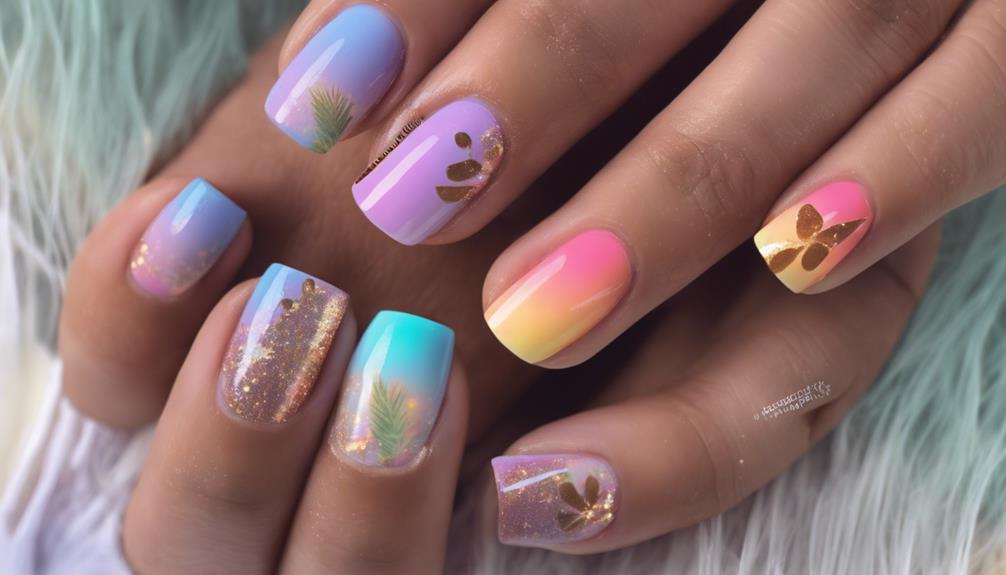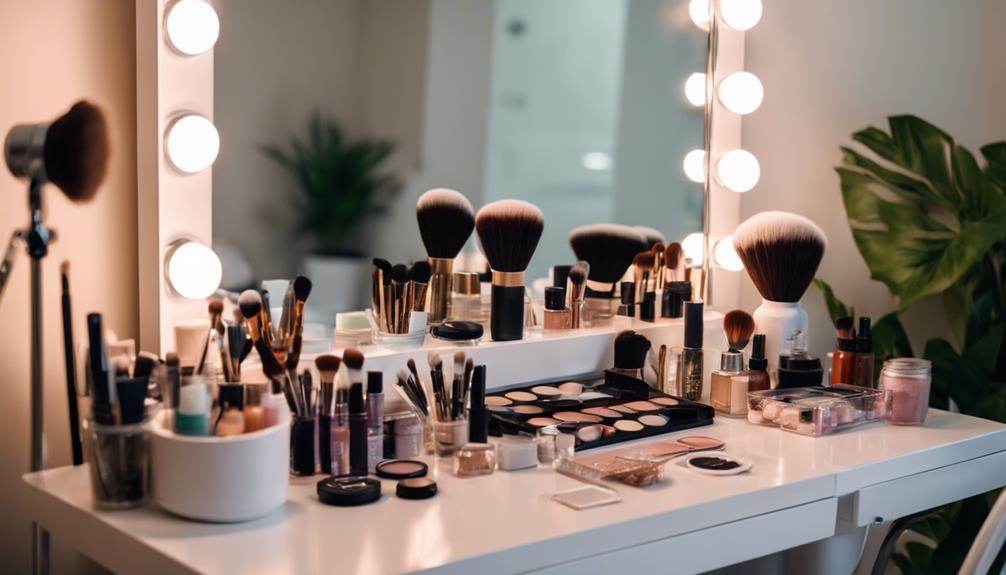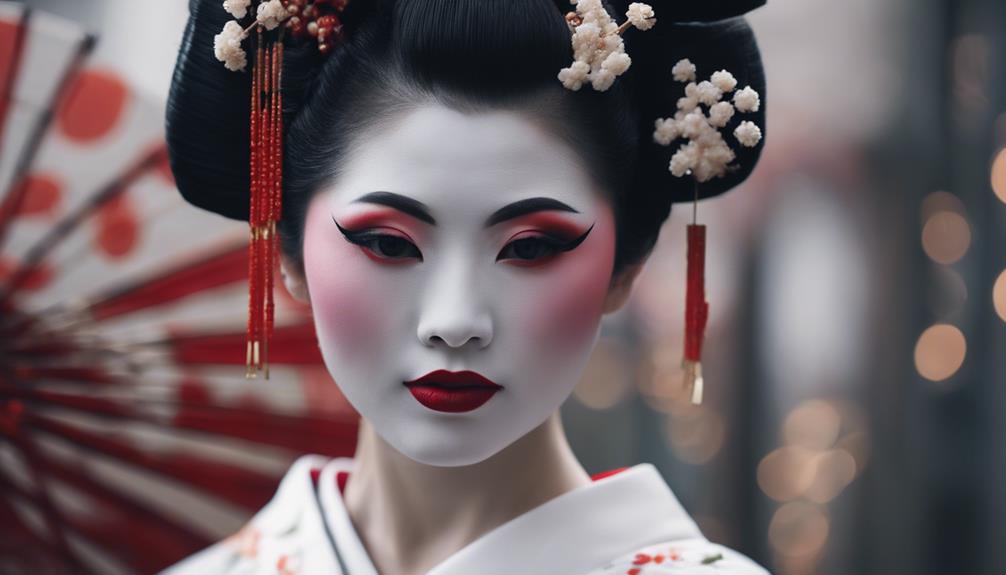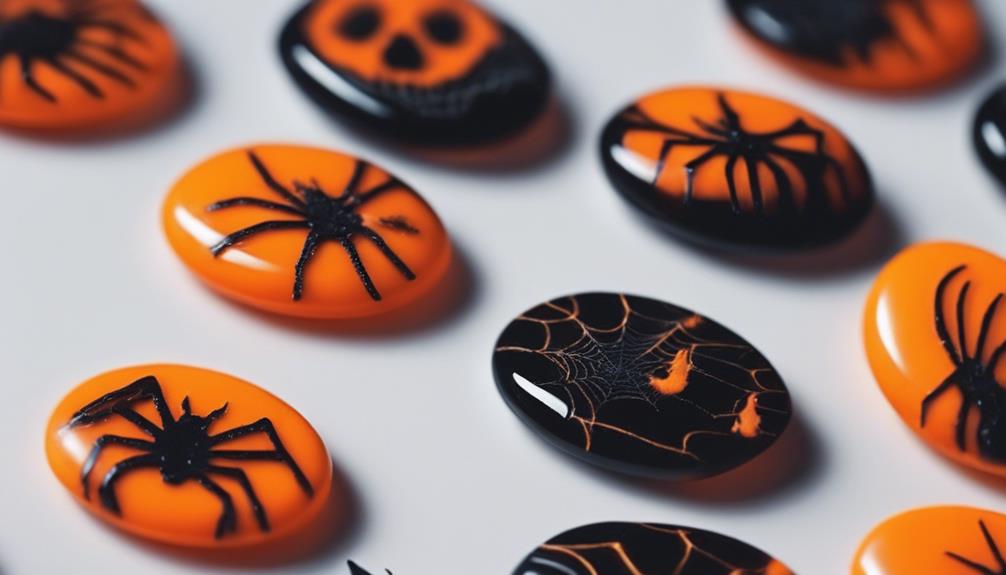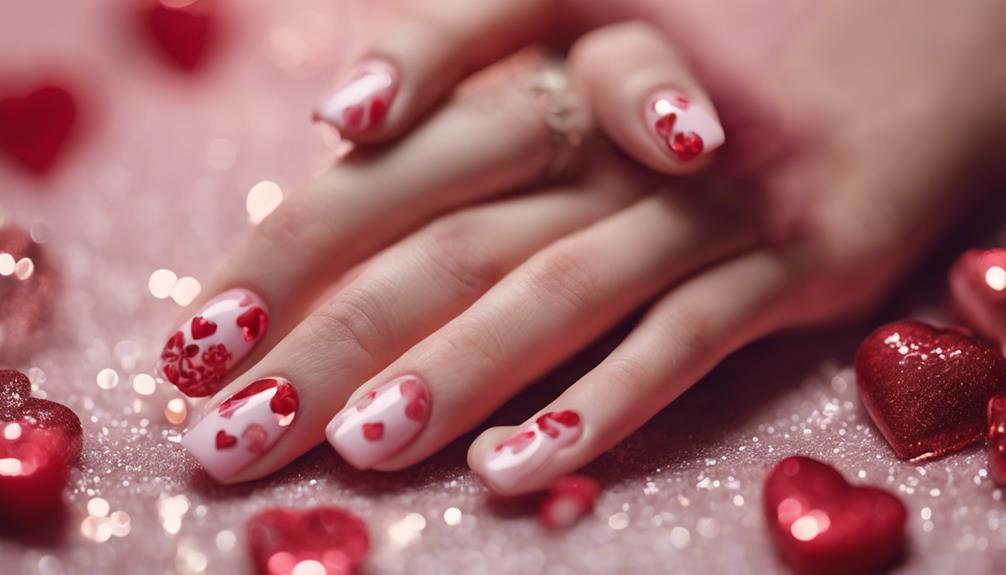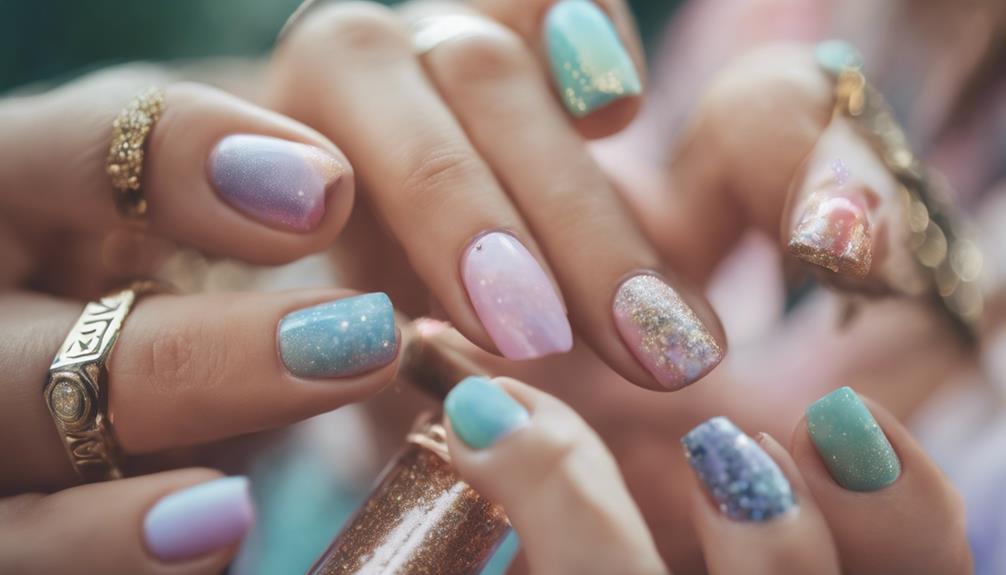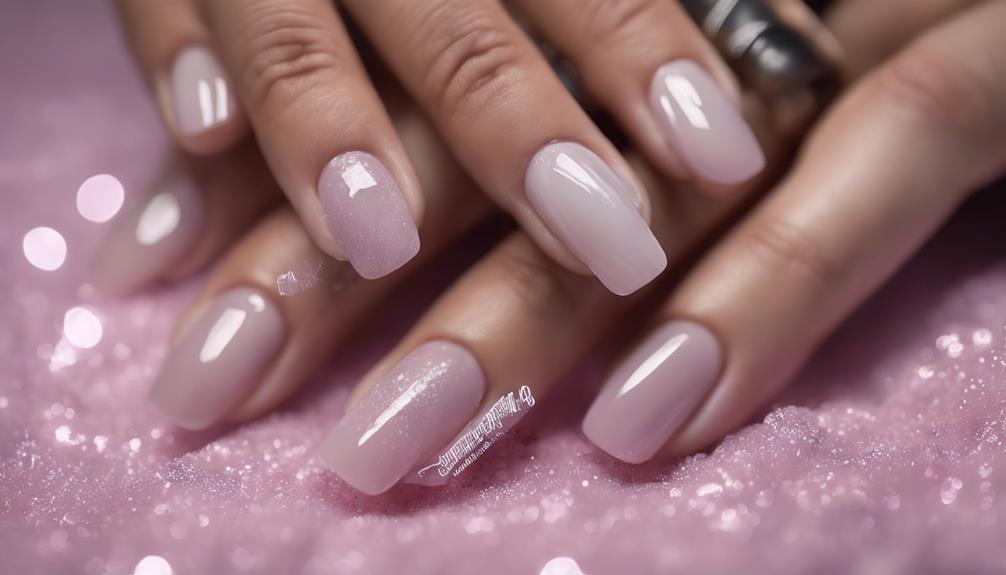Blending Chinese makeup with traditional hairstyles merges historical beauty practices with contemporary flair, honoring ancient Chinese heritage. Techniques such as light foundation, pronounced red lips, and elongated eyebrows from the Ming Dynasty intertwine seamlessly with Tang Dynasty hairstyle inspirations of hairpins, ribbons, and intricate patterns. Hanfu makeup evolution showcases elegance and historical accuracy, bridging past and present beauty trends. Traditional Chinese hair ornaments, like Ji showcasing femininity, further enhance this fusion. Reflecting social status and cultural influences, this blend offers a compelling aesthetic. Discover more about this harmonious fusion of beauty and tradition.
Key Takeaways
- Incorporate Ming Dynasty makeup: pale skin, red lips, elongated brows.
- Use traditional Chinese hair ornaments: Ji, jade hairpins, silk ribbons.
- Integrate Ming Dynasty hair accessories: pearls, precious metals, intricate designs.
- Emphasize symbolic hairpin designs: gold, jade, auspicious symbols.
- Blend elegance of Ming Dynasty makeup with noblewomen's elaborate hairstyles.
Ming Dynasty Makeup Techniques
Exploring the intricacies of Ming Dynasty makeup techniques, we uncover a blend of light foundation, pronounced red lips, and elongated eyebrows.
In ancient Chinese culture, Dynasty Makeup was an art form that aimed for a traditional and elegant look with a focus on simplicity. The use of eyebrow powder was common to elongate eyebrows without a pronounced arch, creating a subtle yet striking effect.
To enhance the facial features, patterns were delicately drawn on the forehead using lipstick and then set with napkin paper for longevity. Additionally, eyeliner was skillfully applied to create long and upward wings at the eye corners, providing a defined look that added depth to the eyes.
These techniques combined to achieve a harmonious balance that highlighted the natural beauty of the wearer while adhering to the cultural aesthetics of the Ming Dynasty.
Tang Dynasty Hairstyle Inspiration
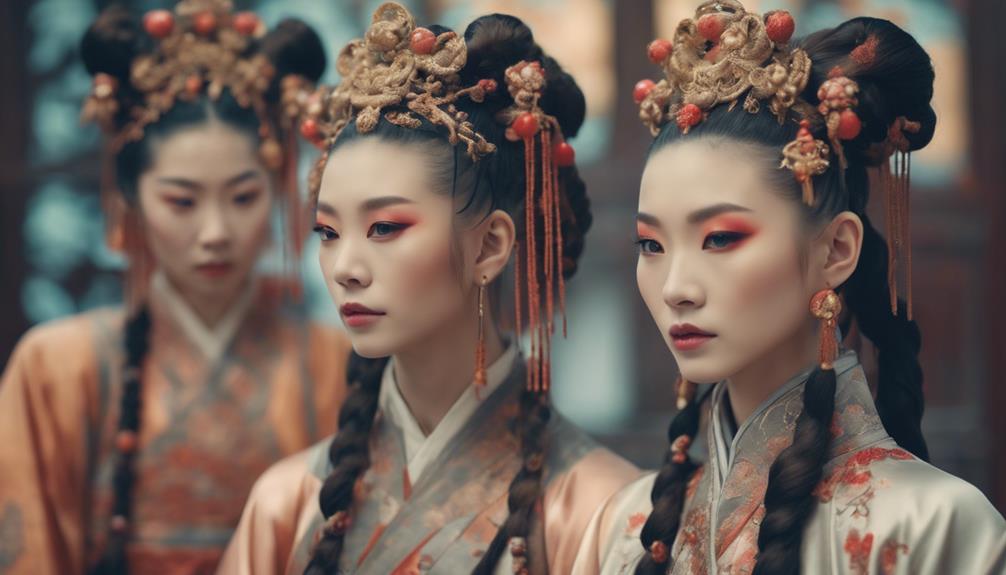
Tang Dynasty hairstyles showcase intricate and elaborate designs, often adorned with accessories like hairpins and ribbons. Women during this period wore their hair in various styles, with Duo Ma Ji and Wo Duo Ji being iconic examples. These hairstyles weren't merely fashion statements but also reflected social status and the prevailing trends of the time. Different occasions and ranks called for specific hairdos, emphasizing the importance of appearance in Tang Dynasty society.
The influence of Tang Dynasty hairstyles can still be observed in modern interpretations, particularly with the resurgence of traditional Chinese hair accessories and braiding techniques. Artwork from that era provides valuable insights into the complexity and beauty of ancient Chinese hairstyling practices. By studying these historical hairstyles, we gain a deeper appreciation for the artistry and cultural significance embedded in Chinese traditions from the Tang Dynasty.
Hanfu Makeup Evolution Overview
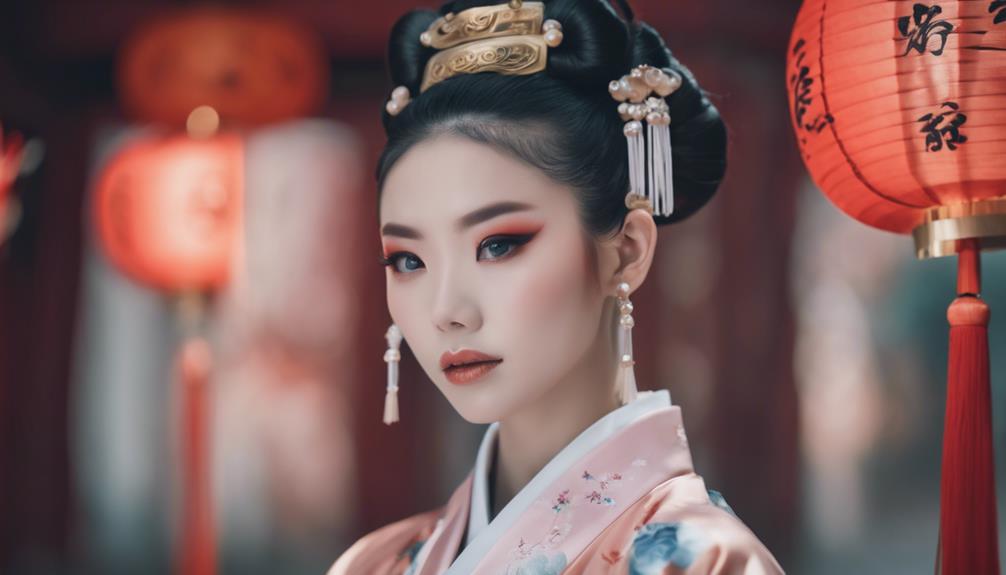
Hanfu makeup evolution showcases a dynamic interplay of styles and trends across different dynasties, reflecting the beauty standards and cultural influences of each era.
From the simplicity of the Han Dynasty to the intricate designs of later periods, Hanfu makeup has been a symbol of traditional Chinese beauty.
The makeup in Hanfu fashion often utilizes natural ingredients and focuses on historical accuracy, with restoration efforts emphasizing detailed charts and thorough historical research to maintain authenticity.
Traditional Hanfu makeup is known for its elegance and sophistication, capturing the essence of the respective dynasties.
Engaging with Hanfu communities can provide valuable insights and guidance on traditional makeup techniques, preserving this cultural heritage for future generations.
The evolution of Hanfu makeup not only highlights the aesthetic preferences of the past but also serves as a bridge connecting contemporary beauty trends with the rich history of Chinese culture.
Traditional Chinese Hair Ornaments
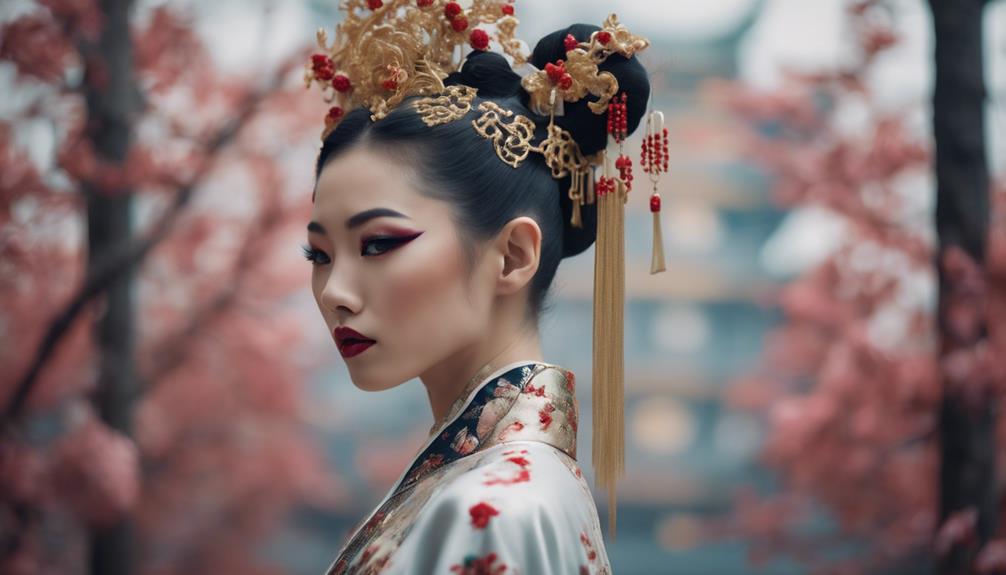
Traditional Chinese hair ornaments, known as 'Ji,' played a vital role in showcasing femininity and elegance, with intricate designs like dragons and flowers. These accessories, crafted from materials such as gold, silver, jade, and pearls, signified the wearer's social standing and prosperity.
Ornamental Hair Sticks, Jade Hairpins Symbolism, and Silk Ribbon Accessories are just a few examples of the rich tapestry of traditional Chinese hair adornments that have stood the test of time.
Ornamental Hair Sticks
Incorporating ornamental hair sticks into hairstyles adds a touch of elegance and cultural significance, reflecting the rich tradition of Chinese hair adornments. These hair sticks, known as 'ji' in Chinese, have been a part of Chinese hair culture for centuries. Made from materials like gold, silver, and jade, they weren't just functional but also symbols of status and wealth.
In traditional Chinese hairstyles, especially in hanfu hairstyles, multiple ornamental hair sticks were used to create intricate and elegant looks. The design and placement of these ji varied depending on the wearer's social standing, the occasion, and personal style preferences. The elaborate nature of these adornments showcased the craftsmanship and attention to detail valued in Chinese culture.
Whether simple or ornate, the use of ornamental hair sticks in Chinese hair styling exemplifies the blend of beauty and tradition that continues to captivate admirers worldwide.
Jade Hairpins Symbolism
Popular in traditional Chinese culture, jade hairpins symbolize nobility, purity, and protection. These exquisite hair ornaments were meticulously crafted with intricate designs from precious jade stones, showcasing the skilled craftsmanship of ancient artisans.
Here are some key points about jade hairpins symbolism:
- Status Symbol: Worn by women of high status during special occasions and ceremonies, jade hairpins were a symbol of prestige and elegance.
- Color Symbolism: The color of jade used in these hairpins held significance; green jade symbolized wealth and prosperity, while white jade represented purity and grace.
- Cultural Significance: The use of jade hairpins in traditional Chinese hairstyles reflected the cultural importance of jade as a symbol of beauty, protection, and affluence.
- Historical Context: Throughout history, these hairpins served not only as decorative accessories but also as meaningful symbols of social standing and cultural beliefs in ancient China.
Silk Ribbon Accessories
Jade hairpins represent nobility and purity, evolving into silk ribbon accessories that were intricately designed to complement traditional Chinese hairstyles. These silk ribbon accessories, popular among noblewomen in ancient times, featured symbolic motifs and vibrant colors to enhance the overall look of the hair. Adorned with pearls, gemstones, and intricate embroidery, these ribbons added elegance and sophistication to traditional hairstyles, signifying social status and wealth. They were a staple in formal events and ceremonies, showcasing cultural significance.
| Symbolic Motifs | Vibrant Colors | Embellishments |
|---|---|---|
| Dragons | Red | Pearls |
| Phoenixes | Gold | Gemstones |
| Lotus Flowers | Blue | Embroidery |
To achieve the desired hairstyle with silk ribbon accessories, noblewomen would meticulously apply powder to their hair, creating a smooth base for the ribbons to be intricately woven into the hair. The combination of intricate designs, vibrant colors, and symbolic motifs made silk ribbon accessories an essential element in traditional Chinese hairstyles, reflecting both beauty and cultural heritage.
Ancient Makeup Trends Unveiled
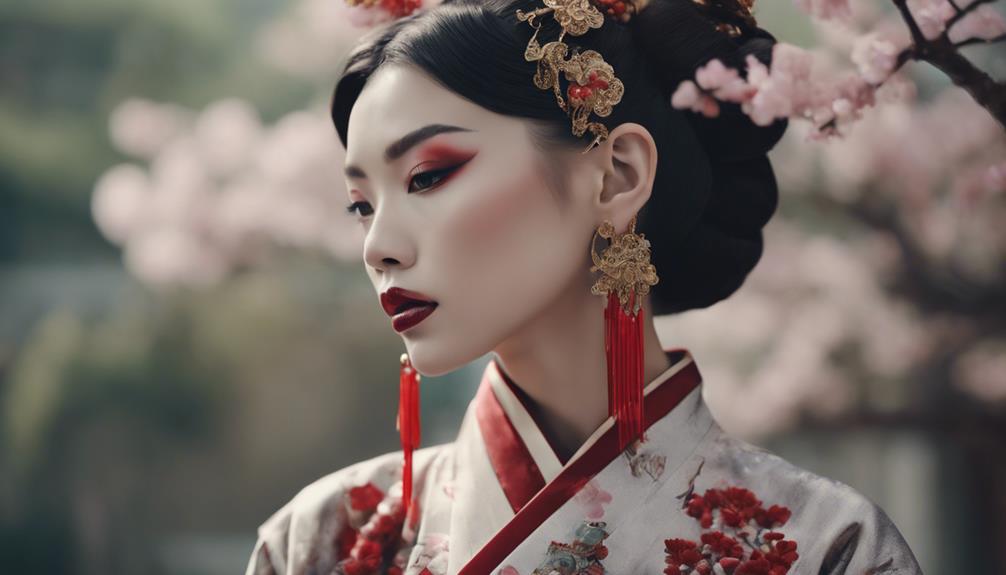
Exploring ancient Chinese makeup trends reveals a fascinating glimpse into the beauty practices of bygone eras. Traditional makeup in ancient China was a reflection of the cultural and societal norms prevalent during different dynasties.
Here are four intriguing aspects of ancient Chinese makeup:
- Ming Dynasty Influence: During the Ming Dynasty, it was common for people to draw eyebrows using a technique that involved creating delicate, curved lines to enhance facial features.
- Natural Ingredients: Ancient Chinese makeup often consisted of natural ingredients, such as rice powder, flower petals, and various plant extracts, highlighting a preference for simplicity and organic beauty products.
- Evolution of Styles: The evolution of traditional Chinese makeup styles over time showcased the diversity and richness of cultural heritage, with each dynasty leaving its unique mark on beauty practices.
- Tang Dynasty Elegance: The Tang Dynasty was known for its diverse and elaborate makeup styles, reflecting the opulence and sophistication of that era's beauty standards.
Understanding these ancient makeup trends provides valuable insights for blending traditional Chinese makeup with authentic historical hairstyles effectively.
Ming Dynasty Hair Accessories

Ming Dynasty hair accessories were more than just ornamental pieces; they held profound symbolism and cultural significance. Hairpins, combs, and clasps were intricately designed with pearls, gemstones, and precious metals, reflecting the wearer's social status and sophistication.
As noblewomen adorned themselves with elaborate ornaments made of gold, jade, and precious stones, Ming Dynasty hairstyles evolved to incorporate intricate metalwork, floral motifs, and symbolic representations like dragons and phoenixes.
Ming Dynasty Ornaments
Numerous Ming Dynasty noblewomen adorned their intricate hairstyles with opulent hair accessories, showcasing their social status and wealth through golden hairpins and phoenix coronets embellished with pearls and gemstones. These ornaments weren't just decorative but also symbolic, representing the wearer's elevated position in society.
The Ming Dynasty hair accessories were crafted with exquisite detail, reflecting the exceptional craftsmanship of the time. Here are some key features of Ming Dynasty ornaments:
- Intricate Designs: Ming Dynasty hair accessories featured intricate metalwork, often incorporating delicate patterns and motifs.
- Precious Materials: The hair accessories were adorned with pearls, gemstones, and sometimes even rare materials like jade, emphasizing the luxury associated with them.
- Symbolic Meanings: Certain designs, such as the phoenix coronets, held symbolic significance, representing power, beauty, and grace.
- Status Symbol: Wearing these elaborate ornaments was a way for noblewomen to display their social standing and affluence, making a statement about their importance in society.
Hairpin Symbolism
Crafted from a variety of luxurious materials, Ming Dynasty hairpins served as essential symbols of social status and personal style preferences. These ancient hair accessories were more than just functional items; they held deep symbolism within their intricate designs.
Ming Dynasty hairpins were often made from precious materials like gold, silver, jade, and adorned with precious stones, reflecting the wearer's wealth and status in society.
The symbolism behind Ming Dynasty hairpins extended beyond mere aesthetics. Intricate designs featuring auspicious symbols such as dragons, phoenixes, and flowers were common, representing power, rebirth, and beauty. These symbols not only added a decorative touch to the hairpins but also carried cultural and historical significance, reflecting the values and beliefs of the time.
While both men and women wore hairpins during the Ming Dynasty, women's hair accessories were typically more elaborate and decorative, showcasing their personal style and social standing. The use of hairpins in this period went beyond mere fashion trends, serving as a reflection of the wearer's identity and cultural heritage.
Hairstyle Evolution
Exploring the evolution of hairstyles during the Ming Dynasty reveals a fascinating intersection of fashion and cultural symbolism through intricate hair accessories. Ming Dynasty hairstyles weren't merely about personal adornment but also served as a reflection of social status and cultural values.
Here are four key points illustrating the evolution of hairstyles and hair accessories during this period:
- Ming Dynasty hairstyles featured elaborate hair accessories such as hairpins, combs, and hair clasps, crafted with intricate designs and often adorned with symbolic elements reflecting Chinese traditional values.
- Noblewomen in the Ming Dynasty showcased their wealth and status by adorning their hair with ornaments made of precious materials like gold, silver, and gemstones, symbolizing their elevated social standing.
- Hairstyles during this period often incorporated intricate braids, buns, and updos, emphasizing elegance and modesty in line with Confucian principles of traditional Chinese style.
- Ming Dynasty hair accessories frequently featured floral motifs and other intricate designs, further highlighting the cultural significance and aesthetic appeal of these traditional adornments.
Tang Dynasty Makeup Tutorial

In recreating Tang Dynasty makeup, one can capture the essence of simplicity and grace through pale skin and red lips. During the Tang Dynasty, traditional Chinese makeup favored a minimalist approach, focusing on enhancing natural beauty with subtle yet striking features. The makeup style included elongated black eyebrows and dark eye makeup that accentuated defined lines. This emphasis on simplicity and elegance reflected the cultural aesthetics and beauty standards of the time.
To achieve a Tang Dynasty-inspired look, start by applying a foundation to create a pale complexion. Then, use a vibrant red lip color to highlight the lips, a signature element of Tang Dynasty makeup.
For the eyes, consider using dark eyeliners and eyeshadows to create a bold yet refined look. Remember to elongate your eyebrows with black pigment to stay true to the historical style.
Hanfu Hairstyle Heritage
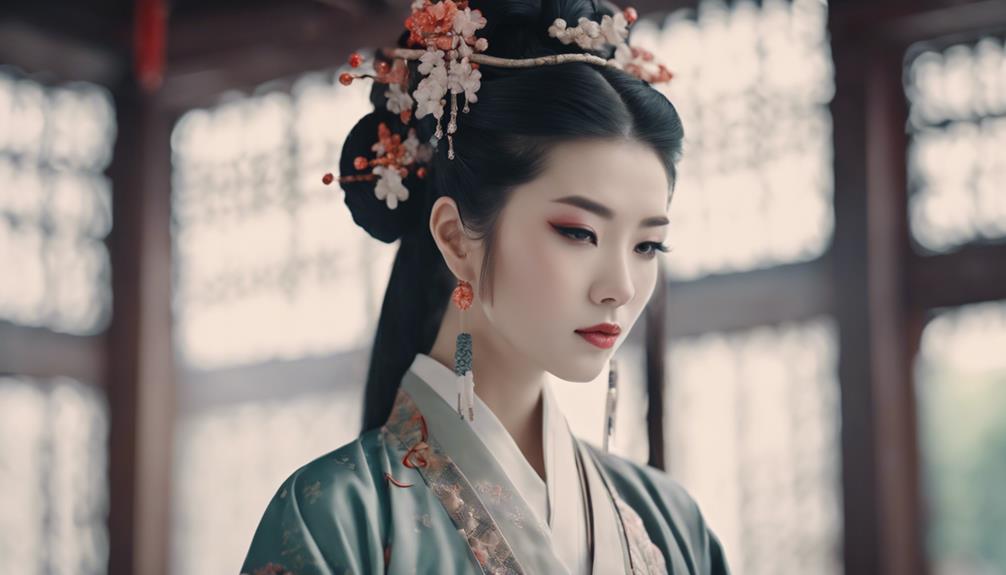
Drawing from the historical influence of Tang Dynasty makeup, the legacy of Hanfu hairstyles in ancient China showcases a rich heritage of intricate and symbolic hair arrangements. Traditional Hanfu hairstyles were more than just hairdos; they were intricate works of art that reflected the wearer's social status, age, and the significance of the occasion. Here are some key aspects of Hanfu hairstyle heritage:
- Elaborate Accessories: Hanfu hairstyles often incorporated elaborate hair accessories like hairpins, ribbons, and ornaments to enhance the overall look and add a touch of elegance.
- Dynastic Influences: Various dynasties, such as the Tang and Ming, played significant roles in shaping the development of Hanfu hairstyles, each contributing unique characteristics and trends to the art form.
- Symbolism and Tradition: Hanfu hairstyles weren't just about aesthetics; they carried deep symbolic meanings and were steeped in tradition, reflecting the cultural values and beliefs of ancient China.
- Modern Revival: Today, modern interpretations of Hanfu hairstyles seek to preserve and pay homage to the traditional beauty and sophistication of ancient Chinese culture, keeping this rich heritage alive in contemporary times.
Chinese Beauty Through the Ages
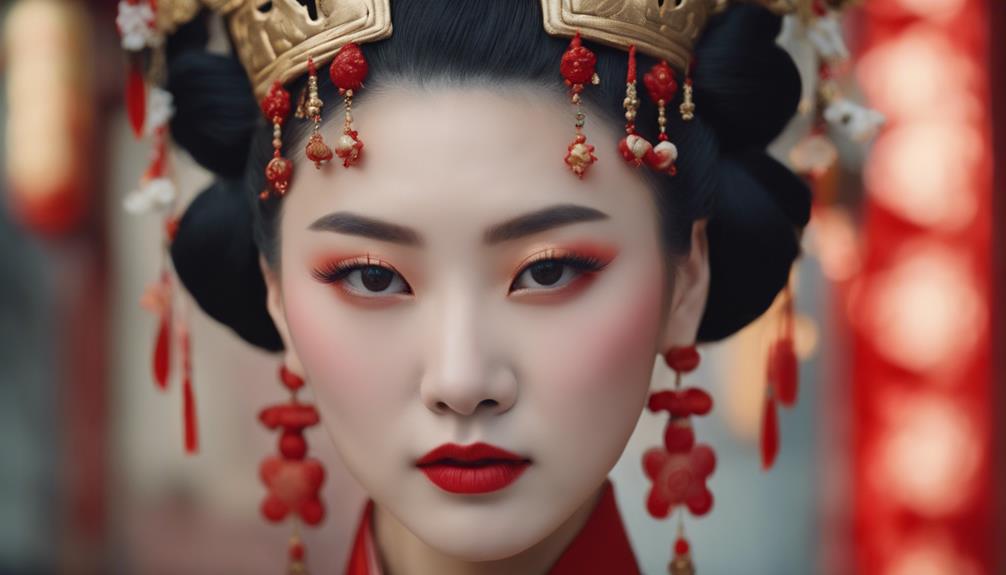
Throughout the course of history, Chinese beauty standards have undergone dynamic transformations, reflecting the diverse makeup and hairstyle trends across different dynasties.
Traditional Chinese hairstyles weren't just about aesthetics; they often held symbolic meanings and incorporated intricate hair accessories.
Makeup in ancient China was more than just a beauty enhancer; it was a reflection of social status, cultural beliefs, and prevailing fashion trends.
Influential historical figures like Empress Wu Zetian left a lasting impact on beauty ideals and makeup styles in Chinese history.
These traditional Chinese makeup and hairstyles continue to serve as a wellspring of inspiration for modern fashion and beauty trends, bridging the gap between the past and the present.
Ming Dynasty Makeup Secrets
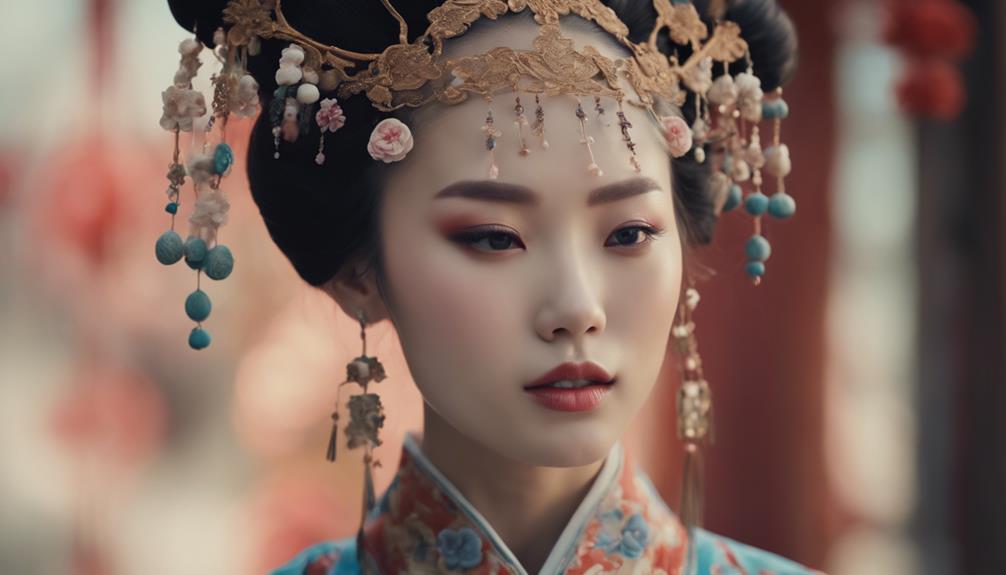
Ming Dynasty makeup techniques centered on achieving a classic look through pale skin, elongated eyebrows, and vibrant red lips.
Makeup tools, such as burnt willow sticks, Dai mineral powder, and stone inkstones, were commonly used during this time.
Ming Dynasty women often adorned their foreheads with intricate patterns to enhance their beauty further.
The significance of wigs in completing Ming Dynasty hairstyles and makeup looks can't be understated.
The makeup style of the Ming Dynasty not only emphasized pale skin, elongated eyebrows, and red lips but also reflected the cultural aesthetics and beauty standards of ancient China. The art of elongating eyebrows was particularly notable, with Dai, a type of mineral powder, being a popular choice for creating this distinctive look.
These makeup secrets from the Ming Dynasty offer a fascinating glimpse into the beauty practices of this ancient era, showcasing a blend of tradition, artistry, and cultural significance.
Frequently Asked Questions
How Do Traditional Hairstyles Influence Modern Chinese Makeup Trends?
Traditional hairstyles hold significant influence on modern Chinese makeup trends. Their intricate designs often dictate the overall aesthetic and color palette of makeup styles. These traditional Chinese hairstyles, such as the iconic “Bian” or hair buns, have inspired makeup artists to incorporate bold and vibrant colors into their looks. In addition, the delicate hair accessories and adornments used in traditional Chinese hairstyles have also inspired the use of intricate and ornate hair accessories in modern makeup trends. Similarly, traditional Japanese hairstyles, like the elegant “Geisha” hairdos, have also had a significant impact on makeup trends, influencing the use of pale, porcelain-like skin and carefully curated color palettes.
By harmonizing with these hairstyles, makeup artists create cohesive looks that honor tradition while incorporating contemporary elements. This fusion preserves cultural heritage while allowing for creativity and innovation in the beauty industry.
The interplay between traditional hairstyles and modern makeup trends showcases a dynamic blend of history and modernity.
What Are the Significance of Hair Ornaments in Ancient Chinese Culture?
Hair ornaments held significant cultural value in ancient Chinese society. They weren't merely decorative but symbolized social status, beliefs, and even marital status.
These ornaments ranged from simple hairpins to elaborate headdresses, each carrying its own symbolism and meaning. Understanding the significance of these hair accessories provides insight into the complexities of ancient Chinese culture and the importance placed on appearance and social hierarchy.
Are There Any Specific Makeup Techniques Unique to the Hanfu Period?
In the Hanfu period, specific makeup techniques were an essential part of cultural expression.
For instance, the use of white powder to achieve a pale complexion was popular, symbolizing purity and nobility.
Additionally, red lipstick was a common feature, denoting vitality and good fortune.
These unique makeup practices not only enhanced beauty but also conveyed deep-rooted cultural meanings, reflecting the values and beliefs of the Hanfu era.
How Has Ming Dynasty Makeup Influenced Contemporary Beauty Standards?
Ming Dynasty makeup has left a lasting imprint on contemporary beauty standards. The dynasty's emphasis on pale skin, defined eyebrows, and subtle lip colors has influenced modern makeup trends.
These historical aesthetics continue to inspire beauty routines today, showcasing a blend of tradition and innovation in the world of cosmetics.
From skin tone preferences to eyebrow shaping techniques, Ming Dynasty makeup has enduringly shaped how we perceive beauty and style.
What Are Some Common Misconceptions About Tang Dynasty Hairstyles?
Common misconceptions about Tang Dynasty hairstyles include the belief that all women wore elaborate hairpieces. In reality, many women styled their hair simply.
Another misconception is that all hairstyles were intricate and time-consuming. While some were elaborate, others were more practical for daily wear.
Lastly, it's often assumed that everyone in the Tang Dynasty had long hair, but short styles were also popular among both men and women.
Conclusion
In blending Chinese makeup with traditional hairstyles, we've uncovered a rich tapestry of beauty that spans centuries.
From the intricate Ming Dynasty techniques to the elegant Tang Dynasty hairstyles, each element tells a story of cultural heritage and artistic expression.
By embracing these timeless traditions, we can create a harmonious fusion of past and present, blending history with modern innovation.
Beauty truly knows no bounds when we draw inspiration from the beauty of the past.

